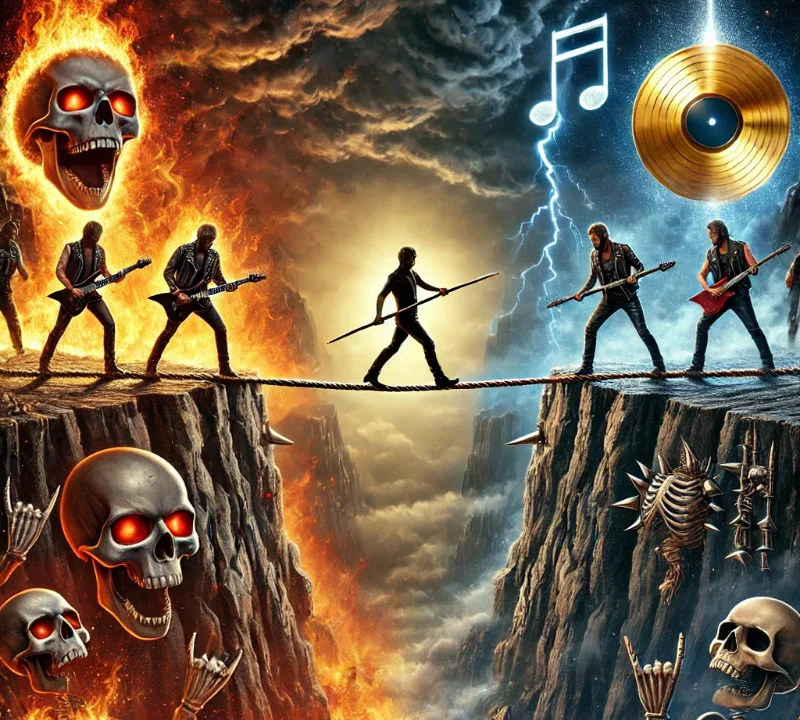
The Band That Walked the Line
The Signs were everywhere in 1990.
A certain strain of Heavy Metal had become commercialized and commodified to ascend the Pop charts, standing shoulder-to-shoulder with the likes of Mariah Carey, Wilson Phillips, Madonna, etc. It felt like an invasion of coiffed, lecherous, big-haired dudes on our TVs and radios, either leering through obnoxious hit fodder or pantomiming sensitivity during their boardroom-approved ballads.
This tactic worked for a few years on the record-buying public, but it also created some division in the Metal world. Many of us loved the Heavy bands who’d maintained their integrity, and found it difficult to watch Metal get publicly redefined as horny, superficial schlock for the mainstream crowd – – all because of a few big-haired opportunists. It didn’t change a note of the albums we loved, but it forced us to take stands and reconcile our place and Metal’s place in the world. It felt, whether it was true/fair or not, like a dividing line had been drawn, with Manowar and Slayer at one extreme and Poison and Britny Fox at the other.
That’s what made Tesla such a miracle. And to be clear, I’m talking about the legendary band from Sacramento, not the 19th century genius inventor or the 21st century car company.


By 1990, Tesla had two fantastic, highly-successful albums, Mechanical Resonance and The Great Radio Controversy, that managed to gain acceptance on both sides of Metal’s Mason-Dixon line. Both albums delivered varied sets of songs, with rockers featuring heavy guitars and shredding twin lead solos, alongside ballads and softer material featuring classical-ish guitar pieces and clean arpeggios or strummed chords. Jeff Keith’s raspy voice could deliver sensitivity or fierce shrieks as needed. They had some minor Rock and Metal hits, but their breakout was a sweet love ballad. “Love Song” would propel Tesla to fame in the hair band lane, but they only sometimes sounded the part. . . and in their jeans-and–shirt regular-guy dress, never looked the part. Their persona was closer to Metallica than Faster Pussycat.

Tesla had plenty of songs about heartache and/or honeyed, smoochy love, plus songs about Cumin Atcha Live and rocking to the top,* but they also interspersed that stuff with biting societal observations, both contemporary and historical (see “Modern Day Cowboy,” “Freedom Slaves,” and “Edison’s Medicine”).
The radio and video stations of the 1990s would soon become less hospitable to bands like Tesla. And bands like Winger. And bands like Overkill. The rise of “Grunge” rendered Metal’s internal territorial pissings obsolete, as far as mainstream coverage was concerned. Some bands thrived, some bands died, but the whole Metal scene went a little further underground, back down from arenas and stadiums to theaters, clubs, and bars. Hair Metal bands either closed shop or got pushed out from their prime spot in the media megaplex to the music biz’s strip malls and flea markets. EZ come EZ go. That’s The Way It Is, the way that it goes. Tesla released an album in 1994, at the height of all that. Bust a Nut was certified Gold in 1995; it’s recognized by the faithful as a classic, in the same league as its predecessors, but it would still be their last with Geffen Records. Bust marked the beginning of their journey into the new Spice World where Bush and pop bands dominated.
Fortunately, unlike many of their peers, Tesla would Hang Tough through that era. Like every long-term band, they’ve had members come and go, bounced record labels, gone on hiatus, and at least one of their guys has released a memoir,* but they never packed it in. Here in the 2020s, forty-some years since their formation, Tesla is still a solid touring attraction. Their slick trip is still going, and they’re still always ready to kick ass.

I’ve devolved into cheerleader mode.
The point of all this isn’t: “Tesla number 1 forever woooo!” It’s that they were in a small, select group that managed to be acceptable to everyone across Rock and Metal’s no man’s land, whether you wore glitter, denim, or loincloths. The guys in Tesla ain’t no fools. Somebody had to walk the line, and they did it.
To their credit, they were one of a kind.
Jack Mangan is best known in the Metal world as lead author/project runner for the “Am I Evil?” graphic novel, as a journalist with MetalAsylum.net and the official Metal Hall of Fame. and also as co-host of the popular (sporadic these days) Metal Hall of Fame and MetalAsylum.net livestreams with Rich Catino. He’s made a few guest appearances as a panelist on The Metal Voice. In an adjacent life, he was a podcast pioneer, with numerous appearances on Technorama, Dragon Page, Escape Pod/Pseudopod, and many others, including his own productions: Jack Mangan’s Deadpan, and the Podcast novel, “Spherical Tomi.” Friend him on Facebook if you can find him, but be warned: he’s not great about checking Facebook Messenger.
~~~~~~~~~~~
Disclaimer: These articles are meant to document and comment on important aspects of Heavy Metal’s broad and diverse history. The views expressed here do not necessarily reflect the opinions of the official Metal Hall of Fame. No mention of any artist should be misconstrued as an indication of intent to induct or deny admittance to the Metal Hall of Fame. We’re not dropping hints here, folks. There will be official press releases when new inductees are ready to be announced.
*Rich Catino suggests “Lady Luck”, “Flight To Nowhere”, “Don’t De-Rock Me” and “Had Enough” from Psychotic Supper, “Action Talks” and “Solution” from Bust A Nut as other bangers.
